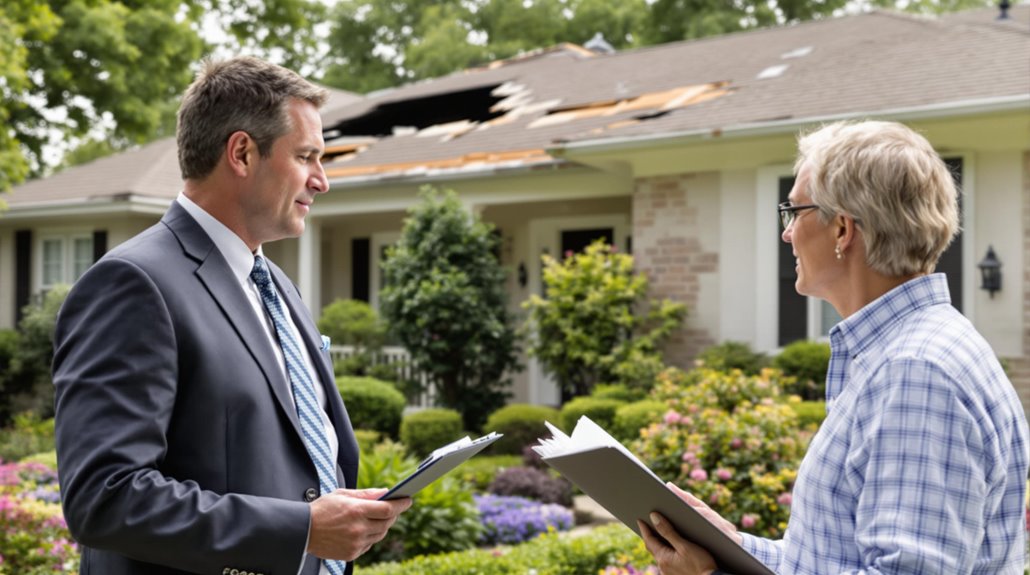Ever wondered what Actual Cash Value (ACV) really means when you're diving into homeowners insurance? Think of it as your item's "here and now" value – like selling your three-year-old smartphone on the marketplace versus what you paid for it new.
In the insurance world, ACV is your reimbursement safety net, but there's a catch: it's not what you paid originally. Instead, it's what your property is worth today after Father Time has taken his toll (that's depreciation in insurance-speak).
Let's break it down with a real-world example: Your beloved leather couch that cost $2,000 five years ago might only be valued at $800 today under ACV. Why? Because insurance companies factor in wear, tear, and age – just like your car loses value the moment you drive it off the lot.
The upside? Your premiums will be friendlier to your wallet compared to Replacement Cost Coverage (RCC). The downside? You'll need to chip in more out-of-pocket when replacing damaged items. Insurance companies use sophisticated calculators and industry standards to determine depreciation, considering factors like:
- Item condition
- Average lifespan
- Market value trends
- Usage patterns
Smart homeowners ask themselves: "Is saving on premiums worth potentially larger out-of-pocket expenses later?" The answer depends on your financial comfort zone and the value of your belongings.
Key Takeaways
- Actual Cash Value (ACV) is the reimbursement amount for property loss, calculated as replacement cost minus depreciation in homeowners insurance policies.
- ACV calculation involves subtracting depreciation from the replacement cost, influenced by factors like age, condition, and expected lifespan of an item.
- Depreciation rates vary by insurer and item characteristics, with insurance companies using established formulas for ACV calculations.
- ACV policies offer lower premiums but provide lower payouts due to depreciation, which may not fully cover replacement costs, unlike Replacement Cost Value (RCV) policies.
- Understanding ACV is essential for homeowners to make informed insurance decisions, as it directly impacts the compensation amount for property losses or damages.
What Is Actual Cash Value in Homeowners Insurance?
In the domain of homeowners insurance, an essential concept governing compensation for property loss is Actual Cash Value (ACV). ACV refers to the amount reimbursed for property loss, calculated as the replacement cost minus depreciation at the time of the loss.
This concept is critical in understanding how homeowners insurance policies provide financial protection against losses or damages to properties. Unlike Replacement Cost Coverage (RCC), which reimburses the cost of replacing a lost or damaged item with a new one, ACV takes into account the item's age, condition, and expected lifespan, thereby reducing the reimbursement amount.
As a result, premiums for policies with ACV are typically lower compared to those with RCC. For homeowners, understanding ACV is essential in making informed decisions about their insurance coverage, as it can greatly impact the amount of compensation they receive in the event of a loss. Public adjusters can assist homeowners in navigating complex ACV claims to ensure fair settlements.
How Is Actual Cash Value Calculated?

Calculating Actual Cash Value (ACV) requires determining the depreciation of an item, which insurers accomplish through standardized methods that account for factors such as age and condition.
The remaining useful life of an item is also an essential consideration, as it directly influences the depreciation rate applied in ACV calculations.
Insurance companies employ established formulas that incorporate these factors to provide a systematic approach to determining ACV for homeowners' personal property.
Working with public insurance adjusters can increase claim settlements by 30-50% through more accurate ACV calculations.
Depreciation Calculation Methods
Determining the actual cash value of a damaged or stolen item requires a thorough understanding of depreciation calculation methods. Actual Cash Value (ACV) is calculated by taking the replacement cost of an item and subtracting depreciation, which reflects the item's age and condition at the time of loss.
- Depreciation is typically determined based on an item's expected lifespan.
- Insurers apply a percentage of the remaining life to establish its current worth.
- Industry-standard methods and factors like wear and tear are used to calculate depreciation.
- Depreciation can vary by insurer and specific item characteristics.
- Insurance adjusters use calculated depreciation to determine the actual cash value of an item.
For high-value possessions, scheduled personal property coverage provides additional protection beyond standard ACV calculations.
Factors Affecting ACV
The calculation of Actual Cash Value (ACV) is influenced by various factors that take into account an item's characteristics, usage, and market conditions.
Depreciation, based on age, condition, and expected lifespan, is subtracted from the Replacement Cost Value (RCV) to determine ACV. The item's original cost, ownership duration, and wear and tear are also considered in depreciation calculations.
Insurance adjusters assess the item's value at the time of loss, comparing it to current market prices for similar items. The remaining lifespan of an item notably impacts its depreciation, with longer lifespans resulting in higher ACV payouts.
Understanding insurance policy terms and depreciation methodologies is essential, as different insurers may use varying methods to calculate ACV. Public adjusters can help identify hidden damages and maximize claim payouts through professional negotiation.
Insurance Company Formulas
Insurance companies employ complex formulas to derive the Actual Cash Value (ACV) of an item, which ultimately determines the claim payout amount. The ACV is calculated by subtracting depreciation from the replacement cost, reflecting the item's value at the time of loss.
Depreciation is determined by the item's age, condition, and estimated useful life, which varies by insurance company. Insurance adjusters use industry-standard methods to assess the current market value of the property and apply the appropriate depreciation factors.
- Depreciation is a key factor in determining ACV, as it accounts for the item's loss in value over time.
- Replacement cost is the amount required to replace the item with a similar one.
- Insurance adjusters use standardized methods to evaluate the item's condition and determine its remaining useful life.
- The ACV formula helps insurance companies determine the claim payout amount.
- Understanding the ACV formula can help policyholders manage their expectations regarding claim payouts.
Working with public adjusters during the claims process can increase settlement amounts by 30-50% compared to handling the claim alone.
Actual Cash Value vs. Replacement Cost Value

When evaluating Actual Cash Value (ACV) and Replacement Cost Value (RCV), it is essential to take into account the replacement cost comparison between the two.
The depreciation value impact on ACV can result in markedly lower payouts compared to RCV, which does not deduct for depreciation.
This difference in policy payouts can have a considerable impact on homeowners' out-of-pocket expenses when replacing damaged or stolen items.
Replacement Cost Comparison
Replacement cost emerges as a vital factor in homeowners insurance, with Actual Cash Value (ACV) and Replacement Cost Value (RCV) representing two distinct approaches to calculating reimbursement for damaged or stolen property.
The primary difference between ACV and RCV lies in their treatment of depreciation. ACV pays the current worth of property after depreciation, whereas RCV covers the full cost to replace property without considering depreciation.
- ACV is typically calculated by taking the replacement cost of an item and subtracting depreciation based on its age and condition.
- RCV guarantees reimbursement for the cost of a new item of similar kind and quality.
- Policies with RCV generally have higher premiums compared to those with ACV.
- RCV provides more extensive insurance coverage, especially for new or valuable items.
Understanding the differences between ACV and RCV is essential for selecting adequate insurance coverage.
Depreciation Value Impact
While the concept of Actual Cash Value (ACV) provides a more conservative approach to calculating property value, its consideration of depreciation can greatly impact the payout amount in the event of a loss.
ACV calculates property value by subtracting depreciation from the replacement cost, reflecting the item's current worth at the time of loss. This depreciation deduction is often substantial, resulting from factors like age, condition, and expected lifespan.
For example, a 10-year-old television valued at $3,500 for replacement may yield an ACV payout of only $1,750 due to depreciation.
In contrast, Replacement Cost Value coverage would provide full reimbursement for replacing items without depreciation, offering more extensive protection under insurance policies.
Policy Payout Differences
The inclusion of depreciation in Actual Cash Value calculations can result in significant disparities in policy payouts compared to Replacement Cost Value coverage. This disparity stems from fundamental differences in valuation methods between Actual Cash Value (ACV) and Replacement Cost Value (RCV) insurance policies.
Key aspects of ACV and RCV policies include:
- ACV policies consider depreciation when determining payouts, reimbursing homeowners for the depreciated value of property.
- RCV policies disregard depreciation, covering the full cost to replace property.
- ACV typically results in lower premiums but may leave homeowners underinsured.
- RCV policies often incur higher premiums but provide greater financial protection.
Homeowners must weigh these trade-offs when selecting insurance policies that balance budget and financial security needs. They should carefully consider factors such as coverage limits, deductibles, and the specific hazards unique to their property. By doing thorough research, homeowners can find a policy that not only fits their financial situation but also provides adequate protection against potential risks. For those looking for clarity on the various options available, homeowners insurance rates explained can offer valuable insights into how different variables affect the overall pricing and coverage options.
Advantages of Actual Cash Value in Homeowners Insurance

Because Actual Cash Value (ACV) policies consider the depreciated value of insured items, they offer several advantages for homeowners seeking affordable coverage options. One key benefit is lower insurance premiums compared to Replacement Cost Value (RCV) policies. This makes ACV policies more accessible to budget-conscious homeowners.
| Advantage | Description | Benefit |
|---|---|---|
| Lower Premiums | ACV policies result in lower premiums compared to RCV policies | Increased affordability |
| Quicker Claims Processing | Simplified valuation of damaged or stolen property using depreciated value | Faster payout |
| Suitable for Fewer Valuables | Adequate coverage for homes with fewer valuable items or newer homes | Cost-effective coverage |
Limitations of Actual Cash Value Coverage

Despite its advantages, Actual Cash Value (ACV) coverage has several limitations that homeowners should consider when selecting a policy. ACV typically results in lower payouts compared to Replacement Cost Value (RCV) due to depreciation. This can lead to significant out-of-pocket expenses, particularly for older items that have depreciated over time.
Some key limitations of ACV coverage include:
- Lower payouts due to depreciation, which may not fully cover replacement costs
- Potential for significant out-of-pocket expenses, especially for older or valuable items
- Industry-standard depreciation methods may vary among insurers, leading to inconsistencies in payouts
- ACV calculations may not keep pace with inflation or rising replacement costs
- Homeowners may face financial shortfalls when relying on ACV for personal property coverage, especially if RCV is not specifically purchased.
Understanding these limitations can help homeowners make informed decisions about their homeowners insurance coverage.
Actual Cash Value and Depreciation: What Homeowners Need to Know

How does depreciation impact the calculation of Actual Cash Value in homeowners insurance?
Depreciation plays a significant role in determining the Actual Cash Value (ACV) of a property by accounting for the item's age, condition, and wear and tear at the time of loss. Insurers consider the expected lifetime of an item and its remaining useful life percentage when calculating depreciation.
For example, a 10-year-old television with 50% of its useful life remaining may have an ACV of $1,750, despite costing $3,500 to replace.
ACV calculations result in lower claim payouts compared to Replacement Cost Value (RCV) policies. Understanding depreciation and ACV can help homeowners set realistic expectations for claim compensation.
Homeowners insurance policies often default to ACV for personal property coverage unless an RCV option is specifically purchased. Recognizing the impact of depreciation on ACV empowers homeowners to make informed decisions about their insurance coverage.
Choosing the Right Coverage: ACV or RCV for Homeowners

Homeowners seeking to optimize their insurance coverage must weigh the pros and cons of Actual Cash Value (ACV) versus Replacement Cost Value (RCV) policies. ACV coverage considers depreciation and typically offers lower premiums, while RCV policies provide full replacement costs without depreciation.
To make an informed decision, consider the following key factors:
- ACV coverage may be suitable for homeowners with fewer valuable possessions or limited financial resources.
- Homeowners with older homes or high-value items may prefer RCV coverage to guarantee they receive the full replacement cost.
- Evaluate your financial situation, age, and condition of possessions to determine which coverage offers better protection.
- Consider the potential out-of-pocket costs required to replace damaged items after depreciation.
- Understanding the differences between ACV and RCV coverage can prevent insufficient funds for replacements and provide peace of mind.
The Benefits Of Consulting A Public Adjuster

When traversing the complexities of actual cash value in homeowners insurance, consulting a public adjuster can provide policyholders with expertise in insurance claims, ensuring a more objective damage assessment and a streamlined claim process.
By leveraging their knowledge of insurance policies and claims procedures, public adjusters can effectively advocate for higher claim payouts and settlements, maximizing the compensation received by policyholders.
As licensed professionals, public adjusters bring a level of proficiency and objectivity to the claims process, ultimately benefiting policyholders in the settlement of their insurance claims.
Expertise In Insurance Claims
In a significant number of cases, policyholders who enlist the services of a public adjuster receive higher claim payouts due to the adjuster's expertise in accurately evaluating property damage and determining the Actual Cash Value of their property.
By leveraging their knowledge of the insurance industry, public adjusters can effectively negotiate with insurers to guarantee policyholders receive a fair settlement based on the true value of their property.
Some key benefits of consulting a public adjuster for insurance claims include:
- Expertise in accurately appraising property damage
- In-depth knowledge of the insurance industry
- Effective negotiation with insurers to address discrepancies in ACV calculations
- Time savings and reduced stress for homeowners
- Contingency fee basis, making their services financially accessible for homeowners traversing the claims process.
Objective Damage Assessment
While maneuvering through the complexities of insurance claims, consulting a public adjuster can provide an objective assessment of property damage, allowing for a more accurate determination of the Actual Cash Value (ACV) of the affected property.
Public adjusters specialize in evaluating the extent of damage and calculating the ACV, which can lead to more favorable claim settlements. They act as advocates for the homeowner, negotiating with insurance companies to guarantee that policyholders receive the full compensation they are entitled to under their policy terms.
Streamlined Claim Process
Although maneuvering through the claims process can be an intimidating task for homeowners, consulting a public adjuster can greatly alleviate this burden by providing expert guidance and support.
Public adjusters are well-versed in the intricacies of homeowners insurance policies, including the differences between actual cash value (ACV) and replacement cost value (RCV). This expertise enables them to effectively advocate for policyholders' best interests during the claims process.
- Provide expert assistance in documenting and valuing damages accurately
- Guarantee all eligible losses are reported to insurance companies
- Handle negotiations with insurance companies on behalf of homeowners
- Leverage knowledge of depreciation and coverage terms to maximize compensation for damages
- Help navigate disputes over claim amounts to guarantee fair evaluations based on property condition and depreciation at the time of loss.
Higher Claim Payouts & Settlements
Public adjusters play a pivotal role in securing higher claim payouts and settlements for homeowners by providing expert assessments of property damage and accurate valuations of loss under the Actual Cash Value (ACV) method. By leveraging their in-depth knowledge of insurance policies, they skillfully negotiate on behalf of policyholders to guarantee all eligible damages are accounted for.
| Benefits | Public Adjuster Representation | Independent Claims Handling |
|---|---|---|
| Claim Payout | 20% to 50% higher settlements | Lower settlements |
| Expert Assessment | Accurate valuations of loss under ACV | Potential undervaluation of loss |
| Time and Stress | Saves homeowners time and stress | Increases time and stress on homeowners |
| Negotiation | Skilled negotiation on behalf of policyholders | Policyholders must negotiate independently |
| Premium Impact | May lead to higher premium savings | May result in lower premium savings |
About The Public Claims Adjusters Network (PCAN)

The search for a reliable and skilled public adjuster can be a challenging task for homeowners traversing the complexities of insurance claims.
The Public Claims Adjusters Network (PCAN) addresses this challenge by providing a national network of pre-vetted, verified, and state-licensed public adjusters specializing in residential and commercial property damage insurance claims.
Key aspects of the Public Claims Adjusters Network include:
- Pre-vetted, licensed, and expert public adjusters in their field
- Members cover over 30 different claim types
- Located in 40+ states
- Mandatory yearly audits of adjuster licenses and complaints
- Highest standards of ethics, morals, and professionalism for its member adjusters
Frequently Asked Questions
What Is the Actual Cash Value in Homeowners Insurance?
In homeowners insurance, Actual Cash Value is the loss assessment amount paid for a covered loss, calculated by subtracting depreciation factors from the replacement cost, never exceeding policy limits, to determine the claim payout amount.
What Is the Disadvantage of Actual Cash Value Coverage of Personal Property?
The disadvantage of Actual Cash Value coverage is its depreciation impact, resulting in lower payouts than replacement cost, often leaving policyholders with significant out-of-pocket expenses, further complicated by policy limits and the claim process.
What Are the Pros and Cons of Actual Cash Value?
Actual cash value benefits include lower premiums, while drawbacks encompass reduced payouts due to depreciation. Comparing valuation methods is vital, as understanding depreciation's impact on compensation is essential for informed decision-making regarding coverage options.
Do Insurance Companies Pay RCV or ACV?
Insurance companies typically default to Actual Cash Value for claim settlements, applying depreciation factors to determine payouts. However, policyholder options may include Replacement Cost Value, which can greatly increase insurance payouts by disregarding depreciation factors.








